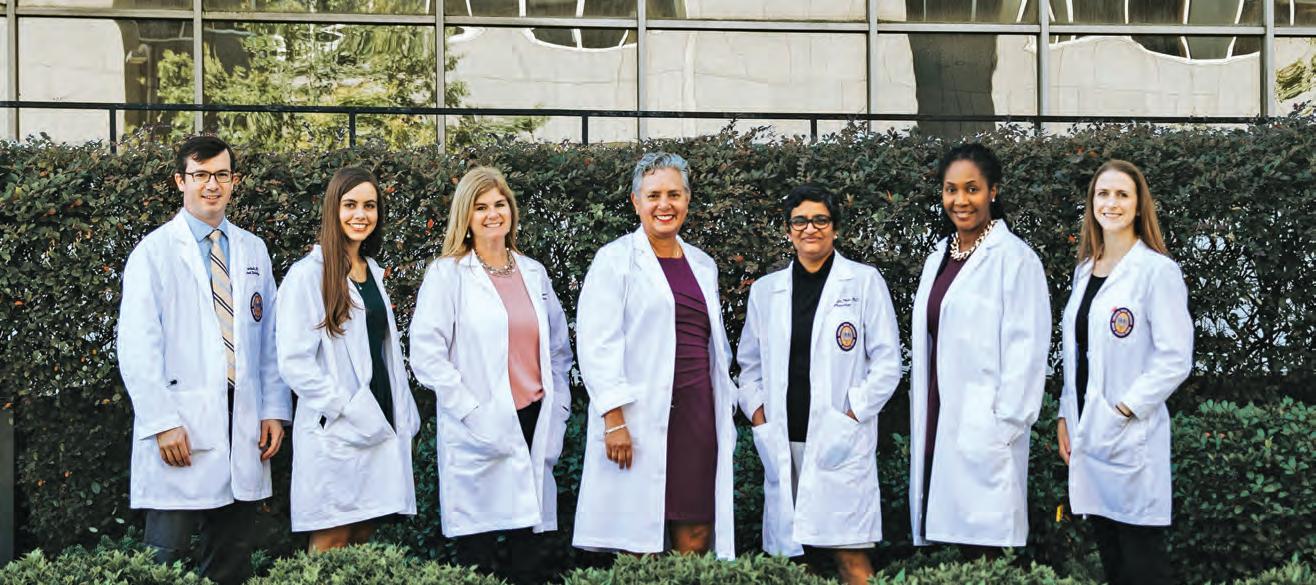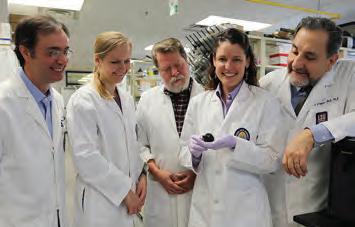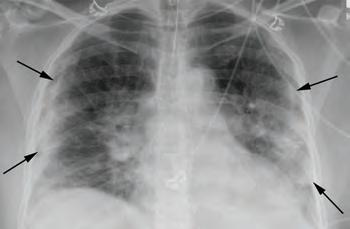
4 minute read
Research Briefs
Leveraging Multidisciplinary Teams from Bench to Bedside
Photo above: Patricia Molina, MD, PhD, center, and the ALIVE-Ex team
Advertisement
The National Institute on Alcohol Abuse and Alcoholism has funded a multidisciplinary team at LSU Health to study the ability of aerobic exercise to improve glycemic control in people living with HIV. The ALIVE-Ex Study, led by Dr. Patricia Molina, Director of the Alcohol HIV/AIDS Research Center, leverages expertise in basic science, public health, radiology and exercise science to translate observations in non-human primates into clinical interventions for subjects.
Advancements in anti-retroviral therapy have allowed HIV infection to emerge as a chronic rather than deadly disease. Therefore, researchers have shifted their focus to better understand why these subjects are at higher risk for metabolic comorbidities such as insulin resistance and prediabetes.
Dr. Molina and her team have designed an aerobic exercise intervention which they believe will greatly increase glycemic control for these subjects. This study is an excellent example of the opportunities that are unlocked for School of Medicine faculty because they are part of a larger LSU University System.
Preventing Blindness in Acadiana
Dr. Jennifer Lentz, Associate Professor of Otorhinolaryngology & Biocommunications and Neuroscience, focuses her research on a specific founder mutation in a single gene. This mutation is the primary cause of Usher Syndrome, the leading genetic cause of blindness and deafness in the world. This syndrome is prevalent in the Acadiana population of Southwest Louisiana.
Isolating this gene is key to a therapy Dr. Lentz is developing which could prevent inevitable blindness for these patients. The antisense oligonucleotide, short pieces of DNA or RNA, are designed to target the mutation and alter it to force the normal expression of the gene.

Dr. Lentz (holding mouse) and her research team
Dr. Lentz has been awarded a 5 year $345,880 National Institute of Health grant to optimize this therapy to prepare for clinical trials.
In parallel, Dr. Lentz and her collaborators are enrolling Louisianans with Usher Syndrome in a natural history study, which aims to learn more about the experience of these patients, including their symptoms and how their disease progresses. Participants receive free genetic testing, which will give researchers insight into the molecular epidemiology of Usher in Louisiana and how it compares to the rest of the world.
Understanding How Alcohol Inhibits Bone Formation
Alcohol abuse during early adulthood results in impaired bone growth, and in the United States approximately 20% of women aged 18-30 binge drink.
Although it is well known that women are more susceptible to the toxic effects of alcohol than men, less is known about the molecular mechanisms underlying alcohol toxicity in women, especially as relates to bone. One of only 30 merit award holders from the National Institute on Alcohol Abuse and Alcoholism, Dr. Martin Ronis has received a 5 year extension to his grant dedicated to better understanding this mechanism.
Dr. Ronis and his team are working on narrowing down the dietary antioxidants which prevent alcohol-induced bone loss. Since this bone loss shares features in common with bone loss during menopause and aging, the outcome of this work may provide fundamental insights into treating this devastating disease.
Treating Pain without Addiction or Toxicity
By Leslie Capo, Director of Information Services
According to the National Institute of Neurological Disorders and Stroke, the burden of pain in the United States is astounding. More than 100 million Americans have pain that persists for weeks to years. Dr. Nicolas Bazan, Director of the LSU Health New Orleans Neuroscience Center of Excellence, and his company South Rampart Pharma have been awarded a $1.9 million Fast-Track Small Business Technology Transfer (STTR) grant to further develop a new class of non-opioid pain relievers discovered and licensed at LSU Health New Orleans.
Current medications for pain are either highly addictive or cause harm to the liver or kidney with overuse. “This startup company represents the clinical translational application of LSU Health’s discoveries, and this grant funding will help us advance the development of one of our lead drugs that as a non-narcotic, has no abuse potential, and lacks the liver and kidney toxicity associated with over-the-counter analgesics,” said Nicolas Bazan, MD, PhD, scientific co-founder of South Rampart Pharma, and Director of LSU Health New Orleans Neuroscience Center of Excellence.
Using Chest X-Rays for Rapid Diagnosis of COVID-19
By Leslie Capo, Director of Information Services
A team of LSU Health New Orleans radiologists investigated the usefulness of chest x-rays in COVID-19 and found they could aid in a rapid diagnosis of the disease, especially in areas with limited testing capacity or delayed test results. Their findings are published in Radiology: Cardiothoracic Imaging.
“In mid to late March, when COVID-19 cases were spiking in New Orleans, we recognized an unusual pattern on x-rays that seemed to correlate with COVID positivity,” notes David Smith, MD, Associate Professor of Clinical Radiology.

The radiologists conducted a retrospective study of nearly 400 persons under investigation (PUI) for COVID-19 in New Orleans. They reviewed the patients’ chest x-rays along with concurrent virus tests. Using well-documented COVID-19 imaging patterns, they categorized each chest x-ray as characteristic, nonspecific, or negative in appearance for COVID-19. They found a characteristic chest x-ray appearance is highly specific (96.6%) and has a high positive predictive value of 83.8% for SARS-CoV-2 infection in the setting of pandemic.
“The presence of patchy and/or confluent, band-like ground glass opacity or consolidation in a peripheral and midto-lower lung zone distribution on a chest radiograph is highly suggestive of SARS-CoV-2 infection,” says Bradley Spieler, MD, Associate Professor of Diagnostic Radiology and Vice Chairman of Research in the Department of Radiology. “We believe this work has great potential to aid all health care providers in the fight against COVID-19.”
Collaborators also include JohnPaul Grenier, MD, an LSU Health New Orleans Radiology Resident and Catherine Batte, MS, from the Department of Physics and Astronomy at LSU Main Campus.










